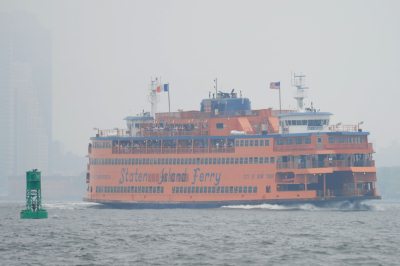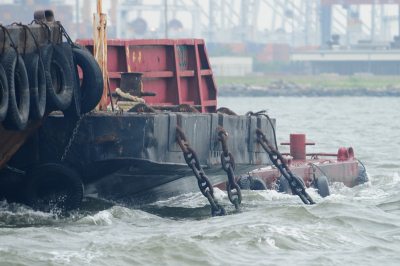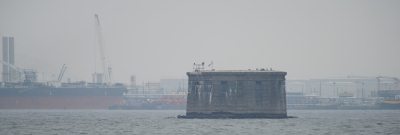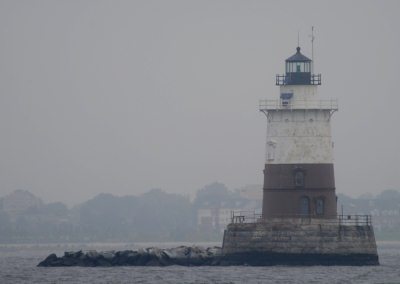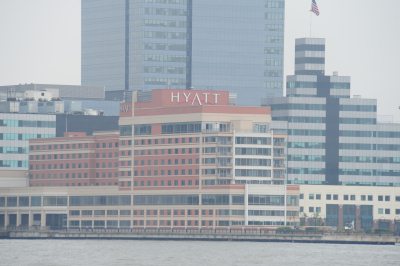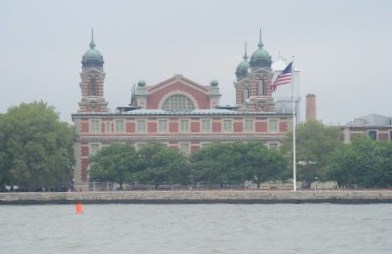Hudson River

|
The Hudson
River
 
The
Narrows: is a tidal stream
between the New
York City boroughs of Staten
Island and Brooklyn, connecting the
upper and lower sections of New York Bay. It has long been considered the
maritime "gateway" to New York City and historically has been the most important
entrance into the harbour. To us Beez Neez entered New York as she
passed under the Verrazano-Narrows
Bridge (we first saw - below - in fairly thick fog) and trotted up
the narrows. The Narrows were most likely formed about 6,000 years ago at the end of the last ice age. Previously, Staten Island and Long Island were connected, preventing the Hudson River from terminating via The Narrows.
 
The Hudson River: is a
three hundred and fifteen mile river that flows from north to south through
eastern New
York. It rises at
Lake
Tear of the Clouds, on the slopes of
Mount
Marcy in the Adirondack
Mountains, flows past
Albany, and finally forms
the border between New
York City and New
Jersey at its mouth before
emptying into Upper
New York Bay. Its lower half is a
tidal estuary which occupies the
Hudson Fjord created during the most recent North American glaciations over the latter part
of the Wisconsin Stage of the Last Glacial Maximum (26,000 to 13,300 years
ago). Tidal waters
influence the Hudson's flow as far north as Troy. At that time, the Hudson River emptied into the Atlantic Ocean through a more westerly course through parts of present day northern New Jersey, along the eastern side of the Watchung Mountains to Bound Brook, New Jersey and then on into the Atlantic Ocean via Raritan Bay. A build up of water in the Upper Bay eventually allowed the Hudson River to break through previous land mass that was connecting Staten Island and Brooklyn to form The Narrows as it exists today. This allowed the Hudson River to find a shorter route to the Atlantic Ocean via its present course between New Jersey and New York City.
 The river is named
after Henry
Hudson, an Englishman sailing for the
Dutch
East India Company, who explored it in
1609. It had previously been observed by Italian explorer Giovanni
da Verrazano sailing for King
Francis
I of France in 1524 as he became
the first European known to have entered the Upper Bay, but he mistook it for an
estuary. The river was named by Hudson's employers the North River (with the Delaware
River called the South River) and formed the spine of
the Dutch colony of New
Netherland. Settlement of the
colony clustered around the Hudson and its strategic importance as the gateway
to the American interior led to years of competition between the English and the
Dutch over control of the river and colony. In the Eighteenth Century, the river valley and its inhabitants were the subject and inspiration of Washington Irving, the first internationally acclaimed American author. In the Nineteenth Century the area inspired the Hudson River School of painting, an American pastoral style, as well as the idea of "wilderness" and "conservation."
  Our first marker and chum as we neared the bridge in fog
The river was called Muh-he-kun-ne-tuk, the Great Mohegan, by the Iroquois, or as the Lenape Native Americans called it in Unami, Muhheakantuck. The Hudson was named the "North River" by the Dutch, who called the Delaware River the "South River." The name "North River" was used in the New York City area up until the early 1900s, with limited use continuing into the modern day. The term persists in radio communication among commercial shipping traffic, especially below Tappan Zee. It was the English who originated the use of the name "Hudson" - because Hudson had found the river while exploring for the Dutch East Indies Company.
  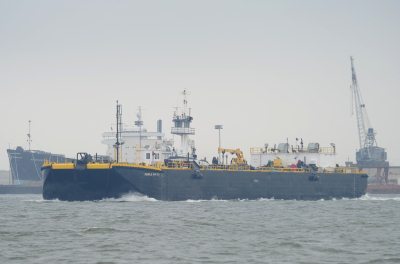   
Some of the girls - anchored and moving we waved to; and some markers - big ones - must be Merica
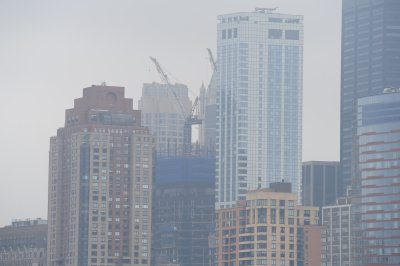 
The skyline, completed for us as we first saw the Statue of Liberty. Tourists hard at it in the Beast, the mix of industrial, homes and businesses
Bear did not fancy being a crane driver on this particular project
Notable landmarks on the Hudson: West Point, Home of Franklin D. Roosevelt National Historic Site, Bard College, the Culinary Institute of America, Marist College, the Thayer Hotel at West Point, Bannerman's Castle, Metro-North Railroad's Hudson Line (formerly part of the New York Central Railroad system), the Tappan Zee, the New Jersey Palisades, Hudson River Islands State Park, Hudson Highlands State Park,Walkway over the Hudson, Sing Sing Correctional Facility, New York Military Academy, Fort Tryon Park with The Cloisters, Liberty State Park, and Stevens Institute of Technology. Cities and towns on the New Jersey side include Tenafly, Fort Lee, Edgewater, West New York, Weehawken, Hoboken, and Jersey City. Cities in New York State include Troy, Albany, Kingston, Poughkeepsie, Glens Falls, Yonkers, Newburgh Beacon and New York City.

The Cunard Line was of course going to welcome the Titanic. Many of their remaining piers are now undercover car parks
The natural beauty of the Hudson Valley earned the Hudson River the nickname "America's Rhine", being compared to that of the famous forty mile stretch of Germany's Rhine River valley between the cities of Bingen and Koblenz. A similar thirty mile stretch on the east bank of the Hudson has been designated the Hudson River Historic District, a National Historic Landmark. The Hudson was designated as one of the American Heritage Rivers in 1997.

What struck us most was the mix of old / new, modern /
renovated, the variety of heights, the sheer size of the river and
all things New York, New York. We look forward to exploring The Big Apple, The
Big Onion and definitely The City That Doesn't Sleep.
ALL IN ALL WHAT A
SKYLINE AND SO BUSY
MORE
SPECTACULAR THAN I
IMAGINED |
